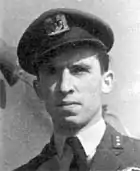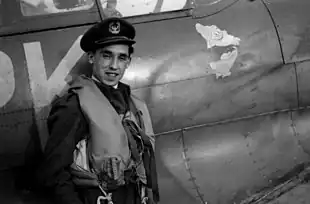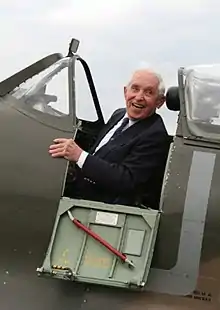Franciszek Kornicki
Franciszek Kornicki (18 December 1916 – 16 November 2017) was a Polish fighter pilot who served in the Polish Air Force in Poland, France and Britain during the Second World War and later served in the Royal Air Force (RAF). He died just a few weeks short of his 101st birthday and was the last surviving Polish fighter squadron commander from the Second World War.
Franciszek Kornicki | |
|---|---|
 Franciszek Kornicki, 1943 | |
| Born | 18 December 1916 Wereszyn, Lublin Governorate, Vistula Land, Russian Empire (now Wereszyn, Poland) |
| Died | 16 November 2017 (aged 100)[1] Worthing, England |
| Allegiance | |
| Service/ | |
| Years of service | 1939–1972 |
| Rank | Pułkownik (Polish Air Force) Squadron Leader (RAF) |
| Commands held | No. 308 Polish Fighter Squadron (1943) No. 317 Polish Fighter Squadron (1943) |
| Battles/wars | |
| Awards |
|
Early life and education

Kornicki was born at Wereszyn, south of Hrubieszów, in Poland, on 18 December 1916, the sixth son of Łukasz Kornicki, a coachman on a large estate, and his wife, Aniela Kornicka. He went to the village school in Wereszyn and then the gymnasium in Hrubieszów, where he boarded and covered his expenses by coaching less able pupils.
Forces career
Eager to further his education but unable to afford university fees, he was admitted as a cadet in the twelfth entry at the Polish Air Force academy in Dęblin. In July 1939, he completed his studies, where he finished in third place out of a class of 173 pupils.[2] In the middle of a fortnight's leave prior to his first posting, he received orders to report to his unit immediately in the general mobilisation as the clouds of war were gathering and said his goodbyes to his family. He never saw his father again and he wouldn't see his mother and brothers again for another 25 years.
German invasion
When the German armies invaded Poland on 1 September, he was a member of 162 squadron flying outdated PZL P.7 aircraft without radios and found the German fighters superior in all respects. The Polish Air Force was heavily outnumbered and losses were heavy, so the fighter squadrons were constantly being pulled back and regrouped. On 17 September pilots were informed at a briefing that the Soviet Army had crossed the border and was moving westwards through Poland and that, to continue the fight, they were to fly to Romania and make their way to France. Those who were without aeroplanes, including Kornicki, who found that his had been taken while he had been at the briefing, were to make their way to Romania overland. With several fellow pilots he crossed into Romania later that same night. By road and rail they travelled to the port of Balchik, which was then part of Romania, avoiding internment and being provided with false papers by the Polish embassy, and they then sailed with many other airmen on the SS Patris to Marseille. It was several months before flying training on the Morane 406 French fighter aircraft was provided, and shortly after Kornicki finished his training news of the French capitulation came through. Together with several thousand other Poles he made his way to Saint-Jean-de-Luz in the Basque country and was evacuated aboard the Arandora Star to Liverpool, where his first task was to start learning English.

Britain
By August 1940 the Polish Air Force already had more than 8,000 men on its strength in Britain and eventually it consisted of sixteen fighter and bomber squadrons had been formed which were operationally subordinate to the RAF. After flying training on the Boulton Paul Defiant he was posted on 11 October 1940 to 303 Squadron, just after it moved north to rest and reform after achieving in six weeks the highest score of all the squadrons that took part in the Battle of Britain. On joining 303 Squadron he converted to the Hawker Hurricane. In January 1941 he joined 315 Squadron, which in July moved to RAF Northolt and was reequipped with Spitfire MkIIs. On 23 July he flew his first mission over France, with the usual instructions to stick close to his section leader. He described the experience as follows: "We were over twenty thousand feet with France below us when I heard on the RT [radio transmitter] that enemy aircraft were approaching, and later there were reports of attacks and warning shouts - somebody was fighting somewhere. I thought we were moving about a bit nervously when I remembered the golden rule: never fly straight and level for any length of time - and so I too weaved behind my energetic leader, trying desperately not to collide with anybody and not to lose him. I managed, but I did not see much else except him and my immediate neighbours. Our squadron was not molested and we all came back in one piece. I landed drenched with perspiration, jumped out of my aircraft, lit a cigarette and inhaled deeply".[3]
On 13 February 1943, he took over command of No. 308 Polish Fighter Squadron: at 26 he was the youngest squadron commander in the Polish Air Force and the first from the twelfth entry at Dęblin to reach such a position. At the end of the month he came down with appendicitis, and on 7 May he became commanding officer of No. 317 Polish Fighter Squadron, which he led until December 1943. From January 1944, having survived over three years as a fighter pilot, Kornicki was transferred to a ground job as a liaison officer. He then attended the Polish Air Force Staff College in Weston-Super-Mare, after which he served in staff positions at 84 Group HQ, 2nd Tactical Air Force, in the Netherlands, Belgium and Germany. As a staff officer he was forbidden to fly operational sorties but he had just received permission to retrain on the latest model of Spitfire when the war in Europe came to an end. For his wartime service he was awarded the Silver Cross of the Virtuti Militari (War Order No. 08487) and the Cross of Valour with two bars.
Post-war

Like many of his fellow-countrymen, Kornicki was dismayed by the Yalta Agreement and had no wish to go to Soviet-occupied Poland after the end of the war.[4] Kornicki joined a course at Nottingham Technical College, but in 1948 he married Patience Williams and they began a career as hotel managers for Symonds Brewery. In June 1951, however, responding to an appeal for pilots for the RAF, which was expanding in response to Cold War pressures, he received a short-service commission as a Flight Lieutenant in the RAF and resumed flying.[5] In May 1953 he switched to the Catering Branch and served on RAF stations in England, Malta, Aden and Cyprus.[6] He was promoted to Squadron Leader on 1 January 1961,[7] and retired from the RAF on 8 January 1972.[8] He subsequently worked for the Gas Industry Training Board and then for the Ministry of Defence.
On 6 March 1948 he married Patience Ceridwen Williams (known as Pat), daughter of Ewart and Enid Williams. Their two sons are Peter Kornicki and Richard Kornicki. His memorabilia, including log-book, French goggles and the attaché case he was issued with at Dęblin in 1936, are in the Polish Museum at RAF Northolt. One of the aircraft he flew, Spitfire MkVB BM 597 is still flying in the colours of 317 Squadron: he was reunited with it at RAF Northolt on the occasion of the 70th anniversary of the Battle of Britain in September 2010, Kornicki then being 93. On 16 June 2011 he was awarded the Commander's Cross of the Order of Polonia Restituta and the award was conferred upon him in person on 24 September 2012 by the President of Poland Bronisław Komorowski. On 11 November 2012 he was promoted to the rank of full colonel (Pułkownik) in the Polish Air Force. He turned 100 in December 2016.[9]
In autumn 2017, in preparation for its centenary in 2018, the RAF Museum organised a poll to select 'The People's Spitfire Pilot' to be featured alongside a Spitfire Mk VB at the Museum's RAF centenary exhibition. Eleven pilots from differing backgrounds were nominated, and Kornicki was the runaway winner with over 325,000 votes (the second placed, British, pilot had 6,300).[10] This was widely reported in the Polish press and on Polish television and radio.[11] In October 2017 he was awarded the Gold Medal of Merit for National Defence by the Polish Minister of Defence.[12]
He died on 16 November 2017 at the Sussex Clinic, a nursing home in Worthing. His wife, Pat, died ten days later, on 26 November. Their joint funeral took place on 30 November 2017 at St Michael's Church, Worthing, in the presence of the Polish ambassador and the head of the Polish Air Force, and they were later interred at Northwood Cemetery, in a plot beside the Polish Air Force war graves. The Polish Air Force provided pall-bearers and colour parties, the Queen's Colour Squadron of the RAF Regiment lined the route with arms reversed, and there was a fly-past by an aircraft of 32 (The Royal) Squadron based at RAF Northolt.
He was posthumously promoted to the rank of Generał Brygady by the President of Poland, Andrzej Duda, in a ceremony held at the Polish Embassy in London on 3 December 2019.
Works
- Polish Air Force – Chronicle of Main Events (1993)
- The Struggle: Biography of a Fighter Pilot (2008) ISBN 978-83-89450-80-7
- Zmagania (2009) [This contains many more original photographs than the English edition]
- Zmagania (2nd edition, 2017) [This contains a new preface, some additional material and more photographs than the first edition] ISBN 978-83-8098-342-7
References
- Zmarł Franciszek Kornicki, weteran walk powietrznych w Wielkiej Brytanii Archived 18 November 2017 at the Wayback Machine (in Polish)
- Kornicki, The Struggle: Biography of a Fighter Pilot (2008) [hereafter simply The Struggle], table of cadets in the 12th entry on pp. 185–190. This book is the source of all biographical information in this article.
- Kornicki, The Struggle], p. 185.
- Kornicki, The Struggle, pp. 114–7.
- "No. 39292". The London Gazette (Supplement). 20 July 1951. p. 3987.
- "No. 39910". The London Gazette (Supplement). 10 July 1953. p. 3861.
- "No. 42241". The London Gazette (Supplement). 30 December 1960. p. 30.
- "No. 45586". The London Gazette (Supplement). 31 January 1972. p. 1276.
- Gosia Prochal (18 December 2016). "Podpułkownik Franciszek Kornicki kończy dziś 100 lat" (in Polish). radiostar.net. Archived from the original on 25 December 2016. Retrieved 25 December 2016.
- The Daily Telegraph, 26 September 2017; "We announce 'The People's Spitfire Pilot'". Archived from the original on 24 October 2017. Retrieved 24 October 2017.
- "Polski pilot wygrał! Franciszek Kornicki będzie symbolem RAF". Archived from the original on 24 October 2017.
- @PolishEmbassyUK 12 Oct [2017]